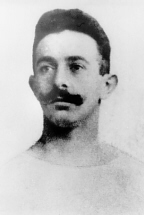
— The International Jewish Sports Hall of Fame, Wingate Institute, Netanya, Israel
Alfred Flatow (1869-1942): At the 1896 Athens Olympics, Alfred Flatow won the individual and team parallel bars competitions for Germany and placed second on the horizontal bar. At the age of 73, Flatow was deported from Berlin to the Theresienstadt ghetto, 40 miles from Prague, on October 4, 1942. He died there two months later, one of the 35,000 Jews who died from starvation while imprisoned in the ghetto.
|

— USHMM #21705/Courtesy of Hans Firzlaff
Johann Trollmann (1907-1943), a Gypsy boxer who was expelled from the German Boxing Association in 1933, died ten years later in the Nazi concentration camp at Neuengamme, Germany. Trollmann was one of up to an estimated 220,000-500,000 Gypsies (Sinti and Roma) killed in countries across German-occupied Europe, victims of Nazi racism.
|
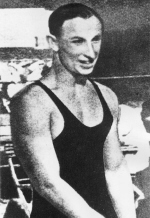
— USHMM #21712/Sports and Tourism Museum, Warsaw, Poland
Ilja Szrajbman (?-1943), national champion for Poland in the men's 200-meter freestyle, swam for the Polish team in the 1936 Berlin Games. Szrajbman was one of tens of thousands of Jews who died from starvation, brutality, and disease during their imprisonment in the Warsaw ghetto.
|
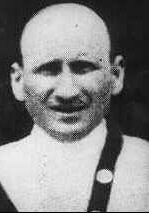
— USHMM #31668/The International Jewish Sports Hall of Fame, Wingate Institute, Netanya, Israel
János Garay (1889-1944), a Hungarian Jewish fencer, won bronze and silver medals for individual and team saber events at the 1924 Paris Olympics and a gold medal in team saber at the 1928 Amsterdam Games. He was one of 437,402 Jews deported from Hungary after Germany occupied that country in 1944. Garay died shortly thereafter in the Mauthausen concentration camp in Austria.
|
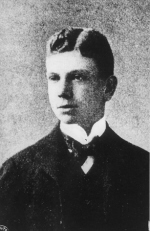
— USHMM #31669/The International Jewish Sports Hall of Fame, Wingate Institute, Netanya, Israel
Dr. Oskar Gerde (1883-1944) won the gold medal in the team saber event at the 1908 London Olympics and the 1912 Stockholm Games. He was deported from Hungary in 1944 and died in the Mauthausen concentration camp. He was one of more than 119,000 prisoners who died in that camp.
|
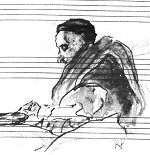
— USHMM #32459/Forum für Sportgeschichte- Förderverein für das Sportmuseum Berlin, Collection of Stefan Flatow
Gustav Flatow (1875-1945), Alfred Flatow's cousin, was on the German team that placed first in the parallel bars and horizontal bar team events at the 1896 Athens Olympics. In 1940 Germany invaded the Netherlands, where he had earlier fled to escape persecution. The former Olympian, at age 70, was deported from Westerbork transit camp in the Netherlands to Theresienstadt on February 26, 1944. This watercolor portrait on sheet music was painted in Theresienstadt three weeks before Flatow's death from starvation. December 30, 1944.
|
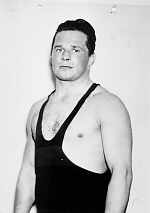
— USHMM #21711/Sportsmuseum Leipzig, Germany
Werner Seelenbinder (1904-1944): German wrestler Werner Seelenbinder finished fourth in the 1936 Olympics competition. Seelenbinder, a Communist staunchly opposed to Nazism, thereby missed the opportunity to mount the winners' podium and defy the Nazis by not giving the "Heil, Hitler!" salute, as he had planned. A member of a resistance group in Germany, he was arrested in 1942 and later beheaded for treason.
|
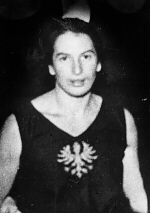
— USHMM #21792/The International Jewish Sports Hall of Fame, Wingate Institute, Netanya, Israel
Lili Henoch (1889-1942): During the mid-1920s, Lili Henoch was a champion shot putter and discus thrower for Germany. She missed the opportunity to become an Olympian in 1924 because Germany, still ostracized after World War I by the western powers, was not invited to the Paris Games. Henoch, with her 66-year-old mother, was deported to the Riga ghetto in German-occupied Latvia on September 5, 1942. Soon after, they were taken from the ghetto with other inhabitants and killed nearby in a mass shooting by Einsatzgruppen murder squads.
|
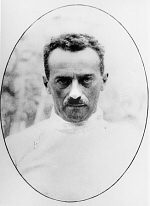
— USHMM #31670/The International Jewish Sports Hall of Fame, Wingate Institute, Netanya, Israel
Dr. Otto Herschmann (1877-194?), an Austrian Jewish swimmer, placed second in the 100-meter freestyle in the 1896 Athens Games. He died in the Izbica transit camp in German-occupied Poland.
|

— USHMM #21710/The International Jewish Sports Hall of Fame, Wingate Institute, Netanya, Israel
Attila Petschauer (1904-1943): At the 1928 Amsterdam Games, Attila Petschauer, a Hungarian Jewish fencer, won a silver medal in the individual saber and gold medal in the team saber. Four years later, he led the Hungarian team that won the gold medal in team saber at the Los Angeles Games. He was tortured to death by antisemitic Hungarian army officers in a forced-labor camp during the war.
|
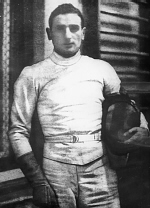
— USHMM #21723/Sports and Tourism Museum, Warsaw, Poland
Roman Kantor (1912-1943), one of Poland's leading fencers, competed in the team and individual épée events at Berlin. He was arrested in Warsaw in 1942 and deported to Majdanek concentration camp and killing center, where he died in 1943. Kantor was one of approximately 3 million Polish Jews murdered during the Holocaust.
|
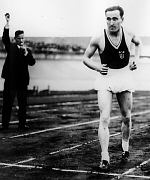
— USHMM #21747/Sports and Tourism Museum, Warsaw, Poland
Janusz Kusocin'ski (1907-1940) set a world record in the 10,000 meters at the 1932 Los Angeles Games, breaking the Finns' traditional domination of the event. An injury prevented his participation at the Berlin Games. After Germany occupied Poland, the national hero, aged 33, was executed in the Palmiry Forest on June 21, 1940. Kusocin'ski was one of thousands of prominent Poles killed as part of a German plan to destroy Poland and enslave the Polish people.
|
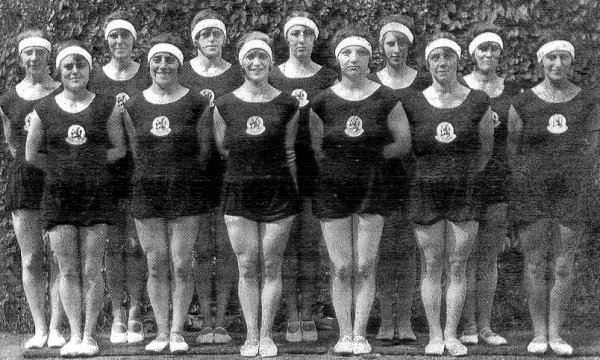 In the 1928 Olympics in Amsterdam, the Dutch women gymanasts won the gold medal in team combined exercises. Four of the ten team members were Jewish. Helena Nordheim (second from left, front row), her husband, and 10-year old daughter were killed by poison gas at Sobibor in Poland on July 2,1943. Anna Polak (third from left, front row) and her 6-year old daughter died July 23, 1943, also at Sobibor; Estella Agsterribe (fourth from left, front row), her 6-year old daughter and 2-year old son were murdered at Auschwitz on September 17,1943. Alternate Judikeje Simons (far right, front row), her son, and daughter, were also killed at Sobibor. Elka de Levi (far right, back row) was the only Jew on the women's team who survived. Two members of the 1928 Dutch men's team -- Jewish gymnast Mozes Jacobs and Jewish gymnastics trainer Gerrit Kleerekoper -- also perished at Sobibor in July 1943.
In the 1928 Olympics in Amsterdam, the Dutch women gymanasts won the gold medal in team combined exercises. Four of the ten team members were Jewish. Helena Nordheim (second from left, front row), her husband, and 10-year old daughter were killed by poison gas at Sobibor in Poland on July 2,1943. Anna Polak (third from left, front row) and her 6-year old daughter died July 23, 1943, also at Sobibor; Estella Agsterribe (fourth from left, front row), her 6-year old daughter and 2-year old son were murdered at Auschwitz on September 17,1943. Alternate Judikeje Simons (far right, front row), her son, and daughter, were also killed at Sobibor. Elka de Levi (far right, back row) was the only Jew on the women's team who survived. Two members of the 1928 Dutch men's team -- Jewish gymnast Mozes Jacobs and Jewish gymnastics trainer Gerrit Kleerekoper -- also perished at Sobibor in July 1943.
|
|
